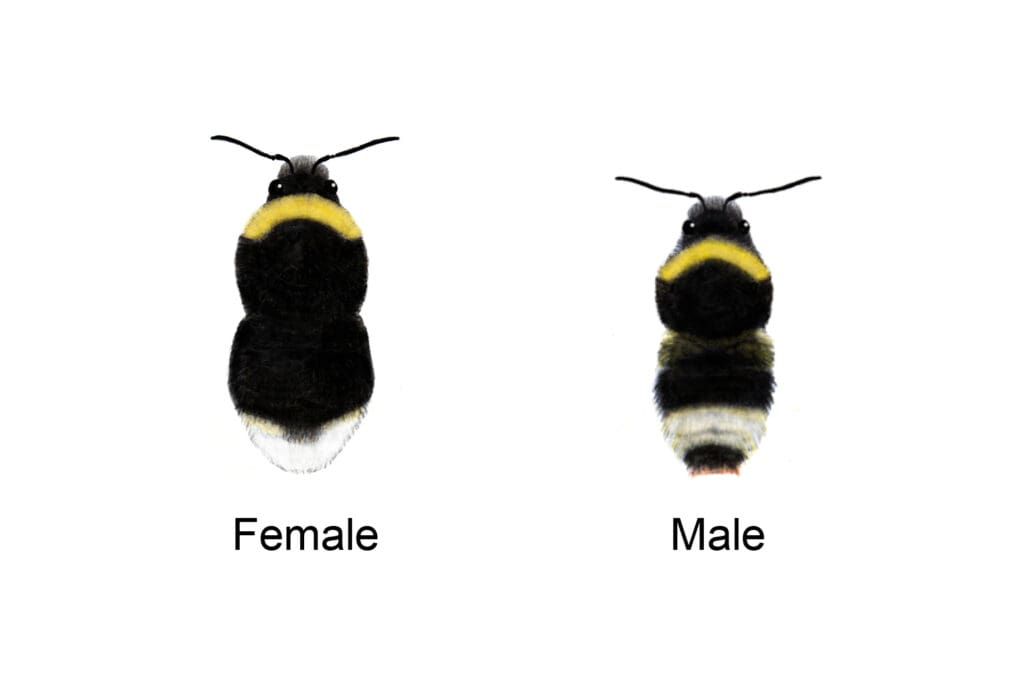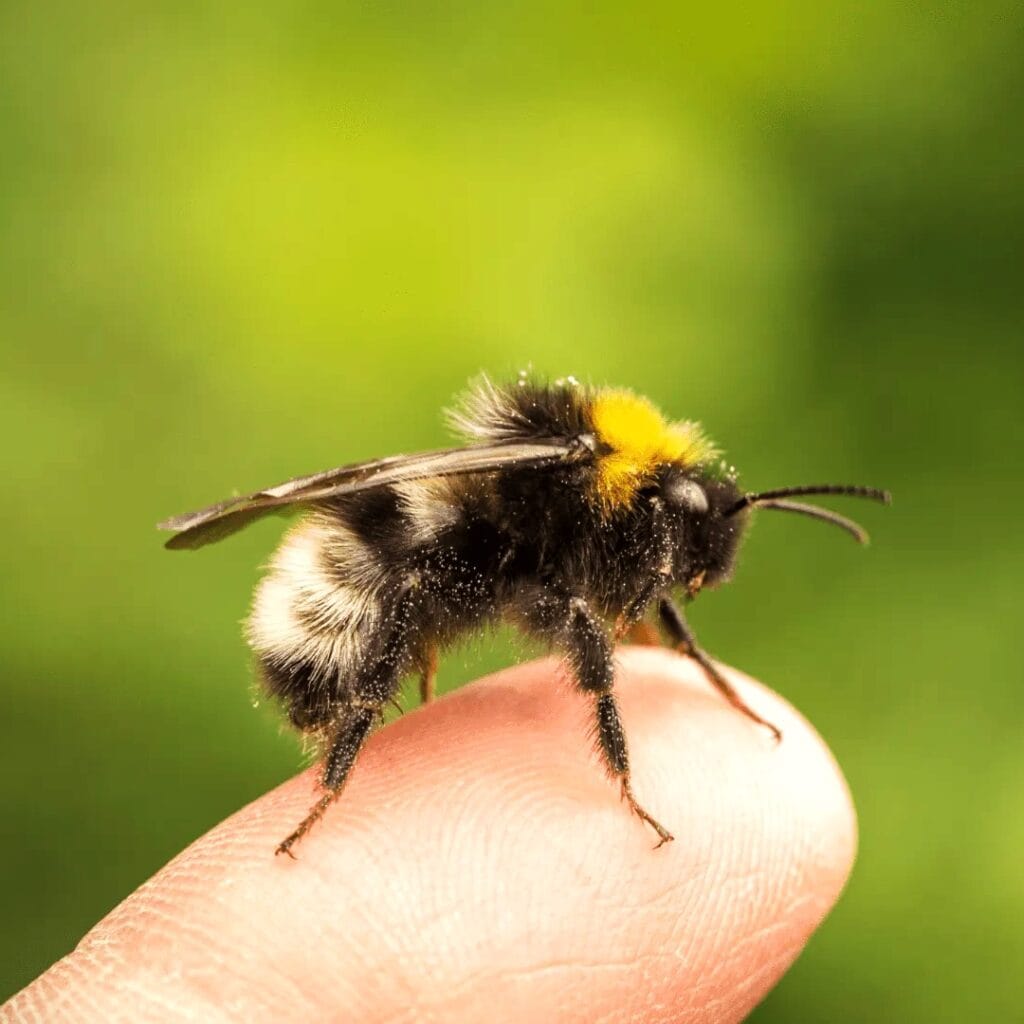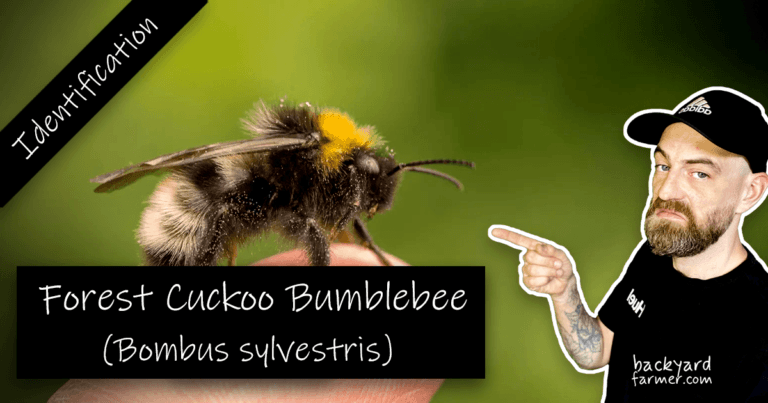Table of contents
Introduction
The Forest Cuckoo Bumblebee (Bombus sylvestris) is one of the UK’s lesser-known bumblebee species. Unlike social bumblebees, it doesn’t build its own nest or have worker bees. Instead, it takes over the nests of other bumblebees, relying on their workers to raise its young—a strategy known as cleptoparasitism.
Despite its fascinating behavior, the Forest Cuckoo Bumblebee is often overlooked because it closely resembles other species. This guide will help you recognize it, understand its role in nature, and explore ways to support bumblebee conservation.

How to Identify the Forest Cuckoo Bumblebee
The Forest Cuckoo Bumblebee has several distinctive features that set it apart from social bumblebees.
Physical Characteristics
- Queen: Medium-sized, black with a strong yellow band at the front of the thorax, a faint yellow band on the abdomen, and a white tail. It lacks pollen baskets.
- Male (Drone): Slightly smaller than the queen, fluffier in appearance, with similar color markings. Some males may have a small brush of red hairs at the tip of the tail.
Key Features:
- No pollen baskets (doesn’t collect pollen)
- Dark, sleek body with yellow bands and a white tail
- Distinctive cleptoparasitic behavior
Identification & Key Facts
| Attribute | Details |
|---|---|
| Common Name | Forest Cuckoo Bumblebee |
| Scientific Name | Bombus sylvestris |
| Size | Queens: ~15 mm, Males: ~14 mm |
| Location | Found across the UK and Europe |
| Active Months | April – September (Females emerge April–June) |
| Habitat | Woodlands, meadows, gardens |
| Nesting Behavior | Parasitic; takes over nests of Bombus pratorum, Bombus jonellus, and Bombus monticola |
| Social Behavior | Cleptoparasitic (no worker caste) |
| Floral Preferences | Thistles, knapweed, heather, wild marjoram |
| UK Status | Widespread, stable populations, classified as “Least Concern” |



Similar Species & How to Differentiate Them
The Forest Cuckoo Bumblebee is often mistaken for other species:
- Field Cuckoo Bumblebee (Bombus campestris) – Lighter in color, with more prominent yellow bands.
- Gypsy Cuckoo Bumblebee (Bombus bohemicus) – Larger and paler, often with white markings.
- Barbut’s Cuckoo Bumblebee (Bombus barbutellus) – Features a clear second yellow band on the thorax.
- Early Bumblebee (Bombus pratorum) – A social species with a smaller body and pollen baskets.
For more details, check out our Bee Identification Guide.
Lifecycle & Behavior
Unlike worker-based bumblebee colonies, the Forest Cuckoo Bumblebee follows a unique lifecycle:
- Emergence (April–June): The queen emerges from hibernation and searches for a host colony.
- Infiltration (Spring–Early Summer): She enters a social bumblebee nest, eliminates the resident queen, and lays her eggs.
- Brood Development (Summer): The host workers unknowingly care for the cuckoo’s young.
- New Generations (Late Summer): Males and new queens hatch, mate, and prepare for hibernation, continuing the cycle.
This behavior makes the Forest Cuckoo Bumblebee an important regulator in bumblebee populations.
Why the Forest Cuckoo Bumblebee Matters
Despite being a parasite, the Forest Cuckoo Bumblebee plays a crucial role in maintaining the balance of bumblebee populations. By targeting specific host species, it ensures that only the strongest colonies survive, contributing to overall ecosystem health.
While habitat loss and pesticides threaten many bumblebee species, Bombus sylvestris remains stable in the UK. Its presence is a good indicator of healthy bumblebee populations.
How You Can Help
Protecting the Forest Cuckoo Bumblebee benefits all bumblebee species. Here’s how you can contribute:
🌿 Plant Bee-Friendly Flowers
Providing nectar-rich flowers helps sustain bumblebees and their hosts. Great options include:
- Best flowers for cuckoo bumblebees: Thistles, knapweed, heather, foxgloves, and wild marjoram.
- Seasonal planting tips: Ensure flowers bloom throughout spring and summer to support both cuckoo and host bumblebees.
🚫 Avoid Harmful Pesticides
Certain chemicals are harmful to bees. Choose organic or bee-safe alternatives instead of using:
- Common pesticides that harm bumblebees: Neonicotinoids, organophosphates, and pyrethroids.
- Natural alternatives: Companion planting, neem oil, and organic pest deterrents.
🏡 Provide Nesting Spaces
- Wild habitat preservation: Maintain wildflower meadows, natural hedgerows, and grassy banks.
- Bumblebee-friendly gardening: Avoid over-tidying your garden—leave some undisturbed areas where bees can find shelter.
By encouraging pollinator-friendly gardening, you’ll help support the Forest Cuckoo Bumblebee and other important pollinators. Check out these RHS tips to create a bee-friendly garden.
Final Thoughts
The Forest Cuckoo Bumblebee is an essential yet often misunderstood part of the UK’s ecosystem. By recognizing its unique role and taking small conservation steps, we can ensure that all bumblebee species continue to thrive for future generations.





